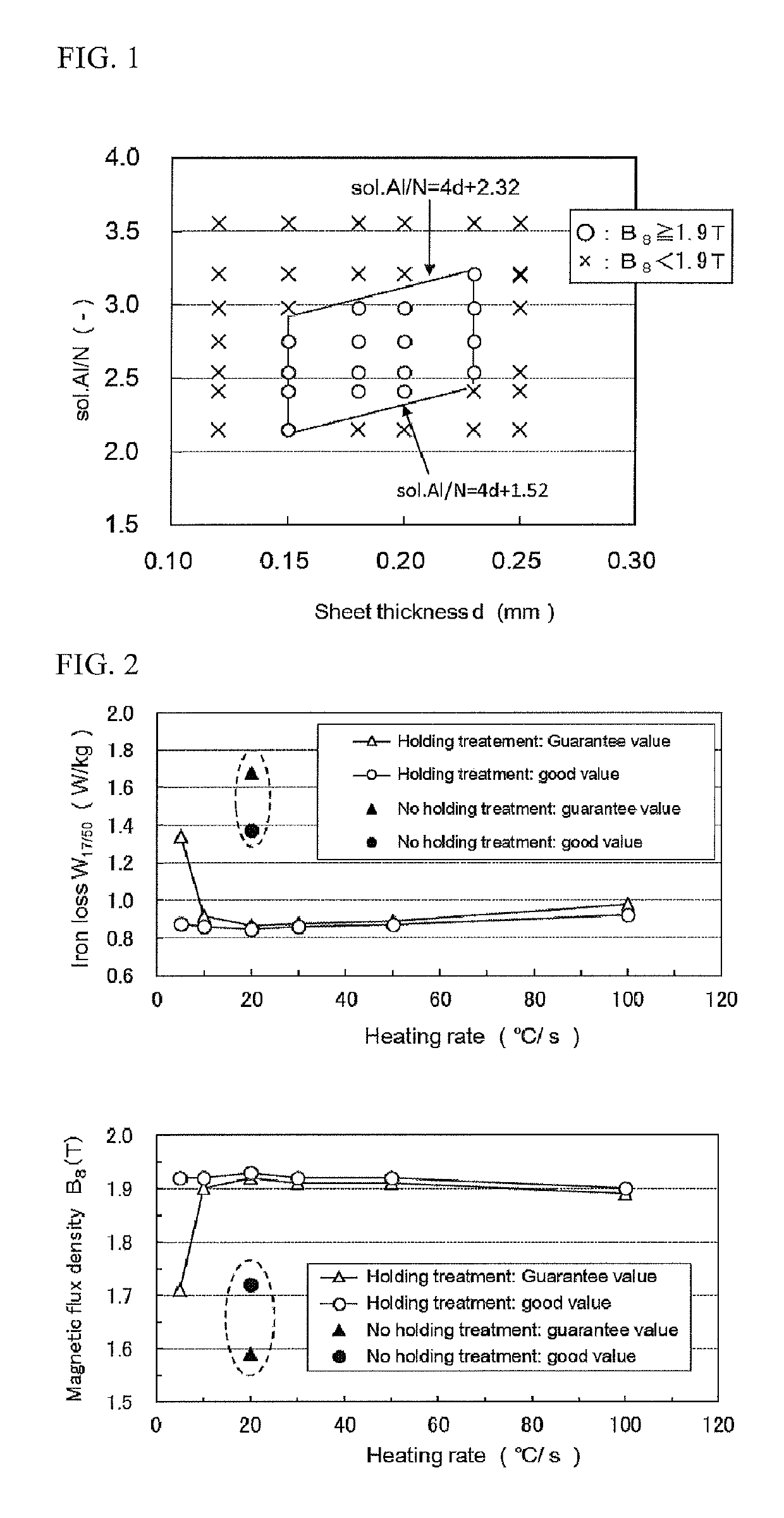Method for producing grain-oriented electrical steel sheet
a technology of electrical steel and grain, which is applied in the direction of heat treatment apparatus, magnetic bodies, furnaces, etc., can solve the problems of poor secondary recrystallization and lowering yield, and achieve the effect of suppressing grain coarseness and reducing the suppressing force of inhibitors
- Summary
- Abstract
- Description
- Claims
- Application Information
AI Technical Summary
Benefits of technology
Problems solved by technology
Method used
Image
Examples
experiment 1
[0028]Each of seven steel slabs having a chemical composition containing C: 0.07 mass %, Si: 3.4 mass %, Mn: 0.07 mass %, Se: 0.015 mass %, Ni: 0.3 mass %, Cu: 0.03 mass % and Sb: 0.04 mass % and having a content ratio of sol. Al to N (sol. Al / N) varied within a range of 2.10-3.56 as shown in Table 1 is hot rolled to obtain a hot rolled coil of 2.4 mm in thickness, which is subjected to a hot band annealing at 900° C. for 40 seconds, pickled and subjected to a first cold rolling to a sheet thickness of 1.5 mm and an intermediate annealing at 1150° C. for 80 seconds, warm rolled at a temperature of 170° C. to obtain a cold rolled coil having a sheet thickness within a range of 0.12-0.25 mm. The coil is degreased and then subjected to primary recrystallization annealing combined with decarburization at 850° C. in a wet hydrogen atmosphere of 60 vol % H2-40 vol % N2 for 2 minutes.
[0029]The, the steel sheet after the primary recrystallization is coated on its surface with an annealing s...
experiment 2
[0033]A steel slab containing C: 0.07 mass %, Si: 3.4 mass %, Mn: 0.07 mass %, sol. Al: 0.020 mass %, N: 0.007 mass %, Se: 0.015 mass %, Ni: 0.3 mass %, Cu: 0.03 mass % and Sb: 0.04 mass % is hot rolled to obtain a hot rolled coil of 2.4 mm in thickness, which is subjected to a hot band annealing at 900° C. for 40 seconds, pickled and subjected to a first cold rolling to a sheet thickness of 1.5 mm and an intermediate annealing at 1150° C. for 80 seconds, warm rolled at a temperature of 170° C. to obtain a cold rolled coil having a final thickness of 0.20 mm, degreased and thereafter subjected to primary recrystallization annealing combined with decarburization at 850° C. in a wet hydrogen atmosphere of 60 vol % H2-40 vol % N2 for 2 minutes.
[0034]Next, the steel sheet after the primary recrystallization is coated with an annealing separator composed mainly of MgO, dried, heated to 850° C. at a heating rate of 20° C. / hr in N2 atmosphere, and thereafter heated to 1200° C. in a mixed a...
example 1
[0089]A steel slab having a chemical composition A-Q shown in Table 3 is hot rolled according to the usual manner to obtain a hot rolled coil of 2.4 mm in thickness, which is subjected to a hot band annealing at 900° C. for 40 seconds, pickled, subjected to primary cold rolling to a sheet thickness of 1.5 mm and further to an intermediate annealing at 1150° C. for 80 seconds, and warm rolled at a temperature of 170° C. to obtain a cold rolled coil having a final sheet thickness of 0.17 mm. Then, the cold rolled coil is degreased and subjected to primary recrystallization annealing combined with decarburization at 850° C. in a wet hydrogen atmosphere of 60 vol % H2-40 vol % N2 for 2 minutes. Thereafter, the steel sheet is coated on its surface with an annealing separator composed mainly of MgO, dried and subjected to final annealing by heating to 850° C. in N2 atmosphere at a heating rate of 40° C. / hr, holding at 850° C. for 50 hours, heating from 850° C. to 1150° C. in an atmosphere...
PUM
| Property | Measurement | Unit |
|---|---|---|
| thickness | aaaaa | aaaaa |
| temperature | aaaaa | aaaaa |
| temperature | aaaaa | aaaaa |
Abstract
Description
Claims
Application Information
 Login to View More
Login to View More - R&D
- Intellectual Property
- Life Sciences
- Materials
- Tech Scout
- Unparalleled Data Quality
- Higher Quality Content
- 60% Fewer Hallucinations
Browse by: Latest US Patents, China's latest patents, Technical Efficacy Thesaurus, Application Domain, Technology Topic, Popular Technical Reports.
© 2025 PatSnap. All rights reserved.Legal|Privacy policy|Modern Slavery Act Transparency Statement|Sitemap|About US| Contact US: help@patsnap.com

